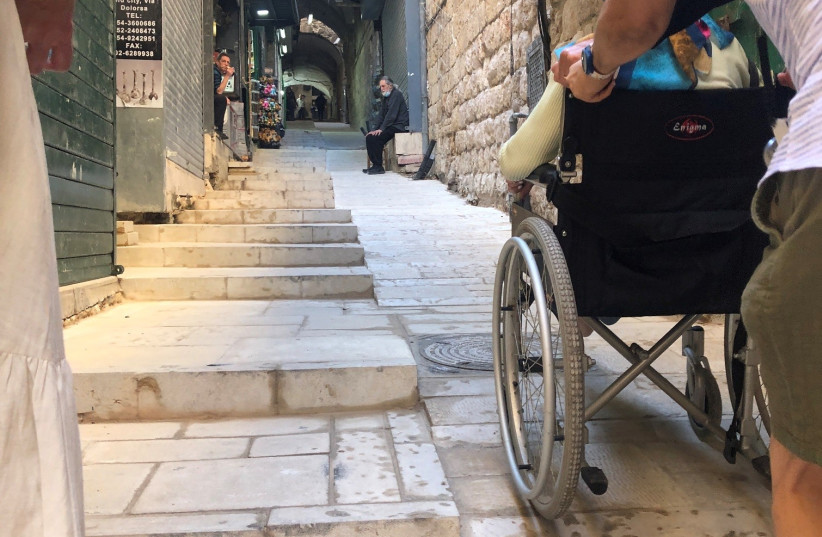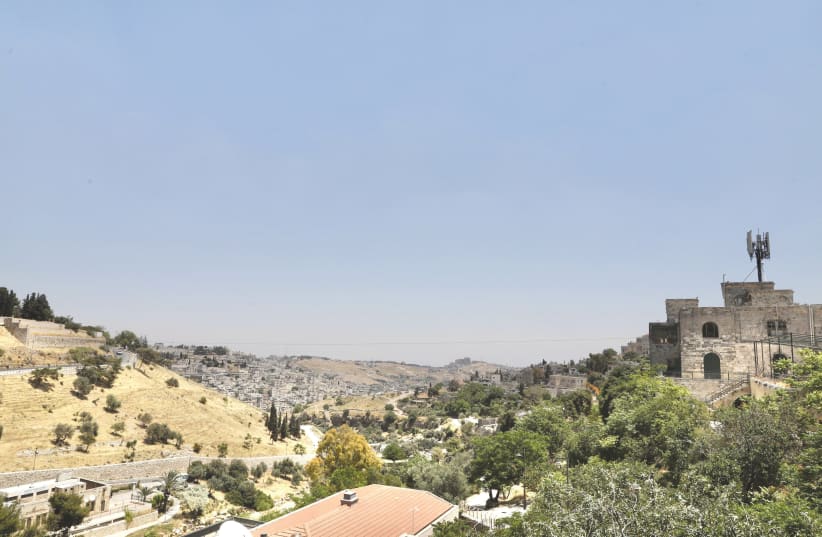The first place veteran tour guide Felix Lev-Ari takes his groups when they come to Jerusalem is the Mount of Olives for a look at the panoramic view of the Old City, with the gleaming golden Dome of the Rock, the age-old walls around the city and the biblical valley surrounding it.
“Tourists and especially pilgrims – both Christian and Jewish – are awestruck by the view of the 2,000- and 3,000-year-old buildings,” said Lev-Ari. “They are amazed by what they see in front of their eyes.”
But now that a Supreme Court decision this week has allowed the controversial cable car project from western Jerusalem to the Old City’s Dung Gate to go ahead, he, along with the many opponents of the project, says it will turn the Historic Basin of the Old City into “another Disneyland or European ski resort” with its poles and carriages causing irrevocable damage to the unique landscape.
Moreover, say opponents, who include archaeologists, internationally acclaimed architects, conservation experts and local residents, the project is politically motivated, aiming to further the goal of expanding the Jewish presence in the Historic Basin Arab neighborhoods through the private right-wing Ir David Foundation (Elad). The foundation runs the City of David neighborhood, where the final station of the cable car is slated to be built.
The project was initially promoted by former tourism minister Yariv Levin and the Jerusalem Development Authority. The Tourism Ministry decided to give precedence to this project over others and to define it as a “national priority,” a category that is usually reserved for advancing infrastructure and road construction projects, thus effectively circumventing the planning committees intended to process such projects.

In their decision Supreme Court Justices Yosef Elron, Alex Stein and Anat Baron on Sunday said the petitioners had failed to prove why the court should intervene in the decisions made by the various committees that had approved the project. Opponents claim that the project, rather than going through the normal planning process review through local or regional committees, was pushed through the national infrastructure committee, preventing public criticism from being expressed.
Although supported by the government, both Transportation Minister Merav Michaeli (Labor) and Environmental Protection Minister Tamar Zandberg (Meretz) have come out against the project.
According to the Jerusalem Municipality, the 1.4 km. cable car line would be able to transport 3,000 passengers per hour along four stops from the First Station entertainment and shopping complex over the Hinnom Valley to the Old City’s Dung Gate, with the final stop at a planned City of David Kedem tourist and visitors center at the entrance to excavations in the Silwan neighborhood, located across the street from Dung Gate, which leads to the Western Wall.
“It works well with the City of David project, bringing in more and more people into a privately owned organization that runs a privately owned national park,” remarked Alon Arad, executive director of the left-wing archaeological group Emek Shaveh, which has led the opposition to the project and promises to continue to do so. “It is nice to see that we have this perspective of how the Jerusalem Municipality works to serve a private organization’s agenda.”
Emek Shaveh said in a statement that the project will have “political and cultural, economic, transportational implications on the city.”
“It is creating an alternative route into the Old City that [will] serve a very limited audience because eventually it is meant to bring people to the [Western Wall], circumventing the old route in from the Christian Quarter and the Armenian Quarter,” said Arad. “The very essence of this project will actually empty the Old City and will bring people from the city to a very specific area in the Old City. There are some interest groups who want to change the demographical and cultural character of the Old City.”
He noted that Church property will also be affected by the project, and said that the fact that most of the project will be built outside the Green Line may pique the interest of some people in foreign ministries abroad.
IF ALL goes as planned, the NIS 200 million project should take about 18 months to complete, said Jerusalem Deputy Mayor Fleur Hassan-Nahoum, who celebrated the court’s ruling on social media along with Jerusalem Mayor Moshe Lion.
“I grew up in Gibraltar, where some places were only accessible by cable car, so cable cars moving above my head were part of our day and did not disturb the heritage of the Rock of Gibraltar in any way,” she said. “The whole city of Jerusalem is moving to car-free. Everyone knows we have to find an alternative solution.”
On average, there are 150,000 visitors to the Old City and 160 events a year for all the various religions in the Old City, Hassan-Nahoum said, and during the peak days of summer, with bar mitzvahs in full swing, “the Kotel gets choked up.” This is no longer sustainable, she said, and a solution had to be found.
The cable cars are an efficient, green, economically feasible and relatively quick solution to the city’s growing traffic and pollution woes, she said. Any light rail line to the Old City will take years to complete, she said.
Lev-Ari said starting the cable car at the First Station near the capital’s Baka neighborhood is simply transplanting the traffic and congestion problem rather than solving it, and as a tour guide it will just add another place where he has to stand in line with groups making sure no one gets lost.
“And Israeli lines are not comfortable for tourists,” he said.
Though the project will involve erecting 15 pylons in key locations along the Hinnom Valley, the carriages will carry only 10 people per trip, with 41 cabins traveling on the line at any given time, with 72 meters of space between each cabin, Hassan-Nahoum said.
“The illustration made by Emek Shaveh is completely erroneous; they have twisted it to make it seem like [the cabins] will be behemoths like in Chicago, but it will be like in Switzerland, where one can barely see them,” said Hassan-Nahoum.
She brushed off charges that the project is political, a claim she said is made about everything in the city, such as when the city planned the light rail train going through east Jerusalem to west Jerusalem. Now, she said, about 40% of the riders on the line are Arabs from the east Jerusalem neighborhoods.
“We needed a station near the Old City, and the closest place we could put a station to get to Dung Gate [was the Ir David Foundation’s City of David]. They are also opening a tourism information center, so it works very well,” she said. She said discussions were held with community members, but she is aware that initially not everybody will be happy with the resulting decision.
Comparing the cable car project to the light rail route, which connects both Jewish and Arab neighborhoods to the city’s center, is disingenuous, said Silwan activist Jawad Siam, and Silwan residents will make little use of the cable cars.
“If they were thinking of our good, why didn’t they make the cable car station in the middle of Silwan, where there are no buses and it is difficult for cars to get through? It is very crowded. Why not make the station in the heart of Silwan? Why in an empty area where there are only tourists?” he said.
Already the village is congested, with little open space, he said, and the half a million tourists arriving to the City of David site, who don’t even realize they are in an Arab village, benefit only Elad.
“We already have very limited air, very limited space. Our life is very limited. The streets are very crowed, and now they are also coming on our roofs, where we still had some open space left, and are taking that from us, too. I don’t want to be watched by tourists like we are some kind of animals in a zoo,” said Siam. “I feel like I am dying. I am not talking about the environment or things that I don’t understand. But how will this serve us? By taking some more of our land? By putting cement poles in our land? Why should I want this? What does it bring for us?”
The cable cars won’t be the first ones to be run in the city, noted tour guide Dov Keinan. Indeed, a cable car that was used during the War of Independence in 1948 to ferry supplies to members of the Harel Brigade who had conquered Mount Zion, forming an Israeli enclave within the Jordanian position, is on exhibit in a small museum in the building where it was used, between the Jerusalem Cinematheque and the Mount Zion Hotel, where one of the stations for the new cable car project will be.
“This is a way to commemorate the history of the cable car on Mount Zion,” said Keinan. “But the main thing is that it will be a really good tourist attraction. The potential of tourism in Jerusalem is much greater than the numbers of tourists who actually come here. It is one of the major tourist attractions in the world, and one problem is having an easy way to get to the [Western Wall] without having to go through the alleyways of the Old City,” he said.
A visit to the Western Wall is “a must” for nearly everyone arriving in the city, regardless of their religion, he said, and not everyone can manage the walk there from Jaffa Gate.
“People who object to the project are the ones who are politically motivated and object to the unification of Jerusalem,” he said.
Tovah Lazaroff contributed to this report.
